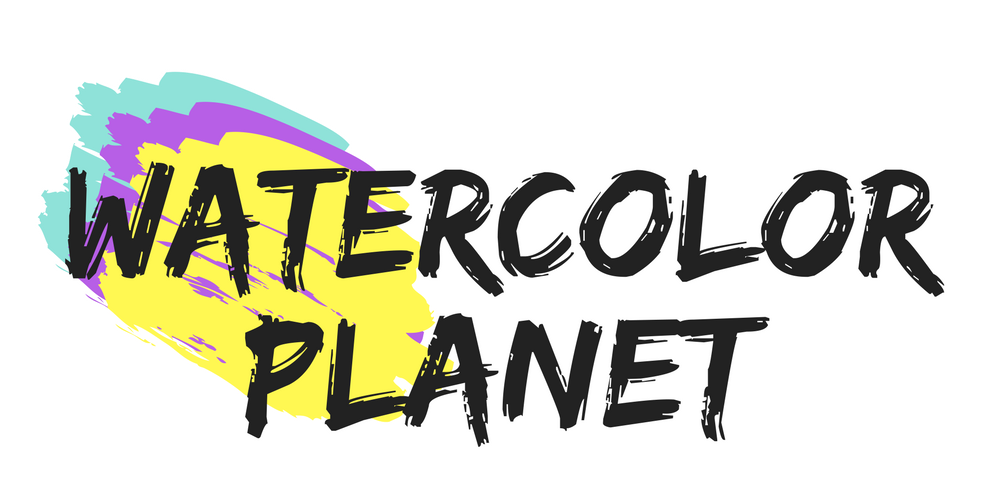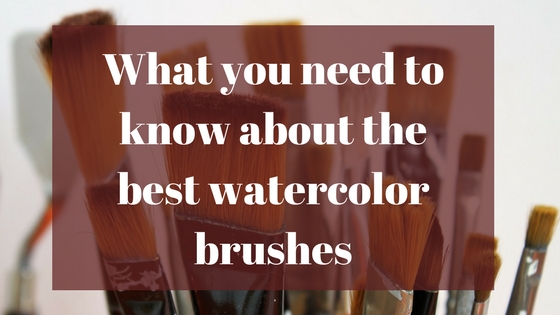Our choice of the best watercolor brushes is as necessary as the choice of other watercolor supplies such as paper and paint. The final result of your work will also depend on the type of brush. It is also necessary to establish a balance between quality and price and look into what are the best watercolor brushes that offer good performance at a convenient price.
Keep in mind that the quality of a brush will make the creative process easier and more pleasant. But it is the ability with the technique that will produce a good artwork. So, it’s not necessarily about having the most costly brush, but one that is suitable —usually mid-range— so you can work with easy and have a good result.
Types of brushes
There are a wide variety of brushes with different tuft shapes that allow us to perform different techniques and details. In addition, it is very important to have brushes of different sizes. Some will help us to apply broad washes, others to create finer details.
Let’s see then the most used types of brushes so you can make your best decision.
Round brushes
These are usually very versatile and are generally the most appropriate for watercolor work. Because of its shape, this type of brushes allows for a great possibility to work with details such as lines and also to apply washes. Therefore, a round brush would be the first choice to start your collection. Of this type of brushes, there are different prices depending on their manufacturing material, but a synthetic round brush must also work pretty well.
Flat brushes
These are especially useful for applying washes and make well-marked lines. It is also useful to create different types of textures, effects, and forms.
Bristle manufacturing
When selecting a brush, its bristles must have certain characteristics that allow the best performance and resistance. It should be able to retain enough water or paint, and then be able to apply the wash smoothly and evenly on the paper.
Brush bristles are made of different materials. Sable bristle brushes are among the best quality brushes. In addition, there are a variety of bristles made of animal hairs such as squirrels and goats that are used to apply washes, although not for brush-strokes that require uniformity.
Then, there are synthetic fiber bristles commonly made of polyester or nylon. There are of different quality. It has generally a good performance. Here it is important to establish a balance between price and quality. Some manufacturers are designing synthetic bristles that allow a better performance. Very cheap brushes may not work as expected.
How to know what are the best watercolor brushes
To know in a practical way what makes a quality brush let’s consider some aspects:
Clean shaping.
The brush must produce a clean and uniform stroke with even edges. There should not be stray hairs alongside the stroke.
Good capacity.
The brush must retain enough water or paint, although the capacity varies according to the size, and type of fibers of the brush. You can check the ability of the brush when you create a long enough line with a single brush stroke.
Continuous release
The paintbrush must continue to release paint constantly even when the angle is slightly changed (45 °), and must not leave dashed lines along the brush stroke. Although this might be common, low-quality brushes tend to constantly create broken lines.
Release variations in function of angles
The amount of paint should vary as the brush is tilted and depending on the pressure applied to the stroke. A vertical position of the brush should produce as much paint as possible in a diluted way, while when tilted the stroke becomes drier and rougher. The quality lies in the ease of controlling this dynamic way of using the brush to get a specific texture.
Precise lining
When using the point of the brush, it should create a thin and sharp line. In addition, you should be able to create small marks either in the form of dots or tiny lines. When creating continuous lines, they should look aligned and uniform.
Variation
It must be possible to create different hues depending on factors exerted with the brush, such as the amount of paint, pressure, speed, dilution, angle. In addition, the texture of the paper influences the nuances.
Balance
The handle must be designed in such a way that brush strokes can be made with control and stability.
The brush should not lose too many hairs. Although at the beginning of its use might be something normal, hair loss later may indicate poor manufacturing.
Durability
The brush must maintain its physical integrity to be suitable for work. In the case of a synthetic brush, its expected useful life is at least six months, while a brush of natural hair, at least two years.
Maybe a single brush does not meet all the requirements above mentioned. In general, it is the high-end and sable hair brushes that will fulfill most of the quality features. But with experience, you will discover that even synthetic brushes can provide a decent result.
Then what brushes to get and how many
To make a realistic decision about what are the best watercolor brushes for you, it is recommended to get hold of mid-range synthetic brushes to get started. You can start with a small collection —3 to 4 brushes— of different sizes which will allow you to experiment with the different basic techniques. The suggested selection is three round brushes, a small one number 2 or 3, one number 6, and one number 10. Also, a 1-inch flat brush.
Over time, if you discover a real passion for the art of watercolor, you might consider getting a high-end brush. The sable and kolinsky brushes seem to be references among professional artists and which seem to meet the features above described. Even though the price seems quite high, keep in mind that these brushes can last several years, which compensates the fact of having to buy cheaper brushes regularly.
Maintenance
In addition to the quality, the performance and duration of the brushes depend to a great extent on the care given to them. It is recommended to clean them after each painting session. Although watercolor is easier to clean than other types of paints and is not damaged if you neglect them at some point, over time the pigment and dirt residues can progressively damage the bristles of the brush, considerably reducing its useful life.
Some recommendations to make sure you keep your brushes clean are:
- Do not let the paint dry on the brushes as it will adhere and be more difficult to remove later.
- Keep brushes clean and dry.
- Store the brushes vertically either in a jug or brush holder.
- Use watercolor brushes exclusively for watercolor painting.
Now let’s take our brushes
After having talked a little about how to choose the best watercolor brushes, it’s time to start experimenting with them. We leave you some exercises so you can familiarize yourself with the technique:
Color bands
Designed to improve your washes technique creating curved strokes with a single color by placing each color in a parallel way, that is, following the shape of the first stroke. You should try not to touch the previous stroke so that white lines are formed between each stroke.
For this exercise you can use a #10 round brush, you can also experiment with a smaller brush to create variations in the same exercise.
Thick and thin
This should be done in a similar way to the previous one but in a more dynamic way. The thickness of the stroke must vary at certain intervals to create an interesting stroke. To achieve, as creating the stroke, press the brush so the bristles expand to make the line thicker, then as you continue with the same stroke decrease the pressure to thin the line.
Wrist flick
The wrist flick is a really exciting technique. I know you’ll have fun with it! You have to do it with a small round brush. We are going to create strokes that mimic the grass form. The stroke begins with the lowest part, then quickly turn the wrist up and slightly to one side so that the top ends up with a plumed shape.
Several of these strokes should create the illusion of grass. You must experiment by varying the size, thickness, direction, and inclination of each stroke.
Painterly strokes
For this exercise, you can use a large round brush. We are going to create strokes putting the length of the tuft completely on the paper. Then you must create different variations of this type of stroke. Paint shorter and longer strokes that slightly overlap the previous ones to create interesting shapes.
Then you can experiment by adding different colors. This technique is very interesting to create expressions in landscapes.
With this, we hope that you can find the best watercolor brushes that meet your needs. You can go to virtual stores such as Amazon or eBay, where you will get an idea of the variety and prices available. You can choose a selection based on a price-quality balance and get the most out of your learning of this wonderful technique of watercolor.



